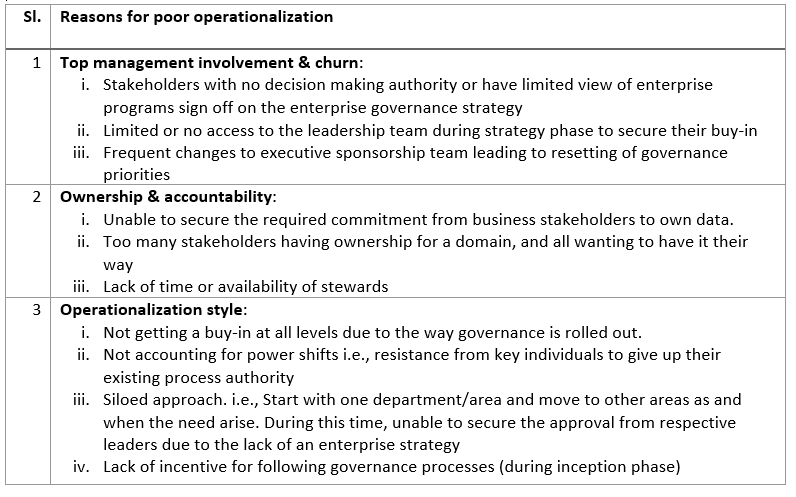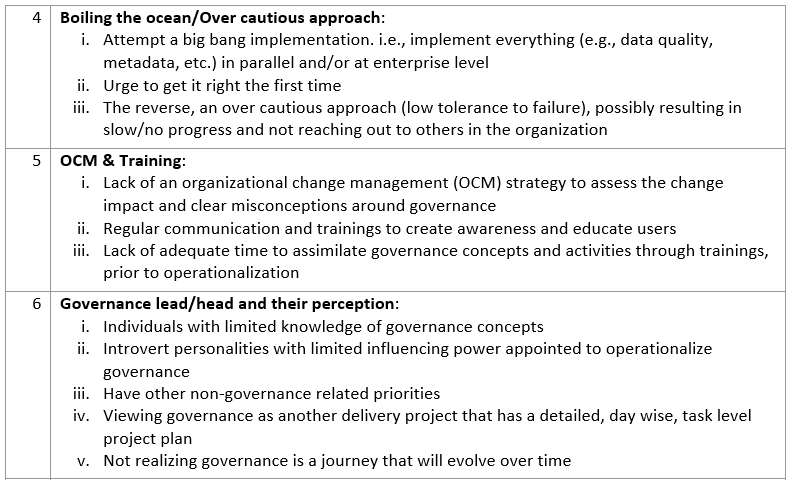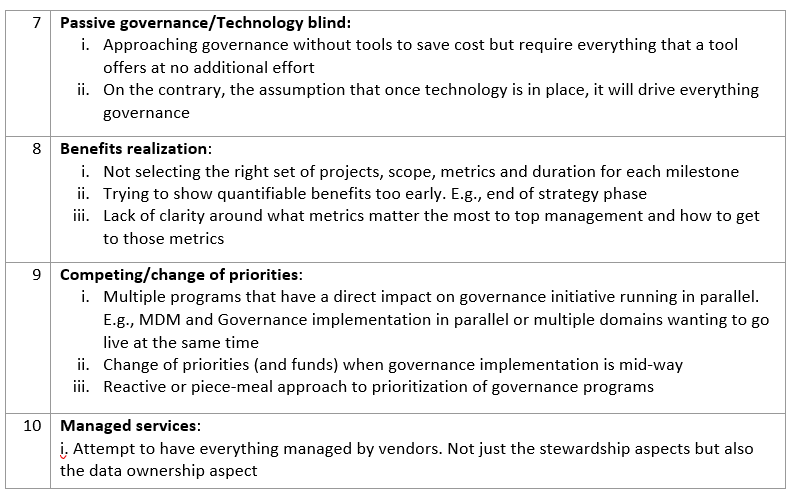Click to learn more about author Jayakumar Rajaretnam.
A decade ago, consultants had to create awareness & educate clients about governance; highlight regulatory risks, compliance requirements, penalties, etc. It was more like selling an insurance product. Today, organizations globally understand what Data Governance (DG) is, its benefits, and the risks of not governing data. In fact, most organizations have a plan/strategy to implement Data Governance. However, when it comes to operationalization, organizations are far behind. If funding and top management commitment is not a barrier, what is hindering the operationalization?
- “Are the recommendations not tailor-made to meet the organizations need?
- “Is the operating model/implementation roadmap lacking detail?”
- “Is the practical implementation feasibility under question?”
- “Is training and/or fear of failure the reason?”
This article is the first in a two-part series that throws light on some of the key people, process and technology aspects that hinder or slow down Data Governance implementation and operationalization.
Where Did it All Start?
Early 2000, the word ‘asset’ represented everything except ‘data’ to business; like investments in technology, infrastructure, workforce, etc. It took a while for the Business to understand the backbone of its organization is ‘data’ and their competitive advantage is directly proportional to the quality of data, it’s management and governance.
The need for Data Governance got critical as the organization grew (both organic and inorganic) and needed a way to be efficient and control costs. To exacerbate the problem, data consumers in the organization started to create shadow marts [1] and process data locally on their desktops for reporting and insights. The impact of this is huge as users can now manipulate and publish data at will, with zero accountability and ownership. In addition, this left the organization vulnerable to data theft, data mishandling, incorrect (regulatory) reporting and wrong insights/decisions.
One solution to this is governance, as it helps with process optimization & standardization, ownership & accountability, efficiency improvement, and control rapid enterprise architecture disruption. Hence organizations started to invest in getting a strategy around Data Governance, allocate budgets and identify stakeholders to take the governance program forward. In some cases, a Chief Data Officer (CDO) role was created and on-boarded.
What is Required to Operationalize Governance?
The fact is, strategy is more like theory and it can only act as a guide for operationalization. Implementing the strategy requires a lot of understanding, communication, buy-in and collaboration at multiple levels within the organization. At a minimum, operationalization requires the act of stewardship (people and process), and tools (technology) to support various aspects of governance. In a nutshell,
- Secure buy-in from all stakeholders involved, irrespective of their level in the organization. The implementation style adopted has a profound impact on this. The three styles are:
- Invasive or Forced: Owners and stewards are informed of their new responsibilities which is more an addition to their existing responsibilities. This style is common in highly regulated industries like banking and financial services where governance is critical. This style has a high resistance rate as governance is seen as an overhead. Also, organizations that have aging employees find it difficult to implement this style.
- Partially invasive or Passive: Only certain critical processes, controls and responsibilities are forced upon owners and stewards. Depending on various parameters like culture, complexity, stakeholder availability, individuals selected for stewardship, etc. this style can go either way in terms of successful operationalization.
- Non-invasive or Blended: Relationship to data defines who shall be the owner and steward. This is the recommended style as the responsibilities directly associate with their existing job functions and relationship to the data. In addition, this style has the highest adoption/buy-in ratio among the three styles.
- Address the three components of governance (People, Process & Technology) together. Though at the time of implementation, one can address these components one at a time, during operationalization, they must go together. For example, having people and process components addressed without the technology component can lead to frustration, inefficiencies and high cost of operation. Similarly, having people and technology components in place, without the processes can lead to chaos and confusion due to the lack of standardization and control. (Refer Figure: 1).

- Accept Data Governance is a journey that evolves over time.
- Embrace a phased approach with pilot roll-outs
- Fine tune the processes as you expand to other data domains and business units
Where does it take a turn?
Based on the analysis of 19 organizations spread across Banking and Financial services, Insurance, Energy & Utilities, Retail, Technology, Communication and Manufacturing, strategy is not really the bottleneck. The Top 10 reasons cited for poor operationalization are:
The second part of this series is “Data Governance Operationalization: The Team.” It will publish on November 12th, 2018.
Survey Methodology
The survey included studying 19 organizations spread across Banking and Financial services, Insurance, Healthcare, Energy & Utilities, Retail, Technology, Communication and Manufacturing domains. The organizations were at various levels of maturity and implementation progress. Mode of analysis: Combination of survey and interaction with subject matter experts close to data management at the respective client locations.
Part 2 of this article series is at: Data Governance Operationalization: The Team
[1] Stand-alone marts are databases developed outside of the Enterprise Data Warehouse (EDW). E.g., Excel files, MS Access database setup at desktop.





